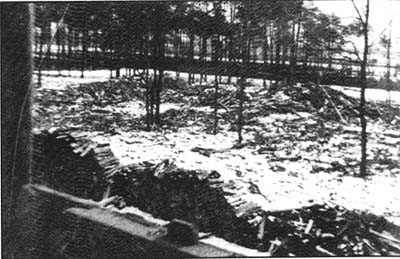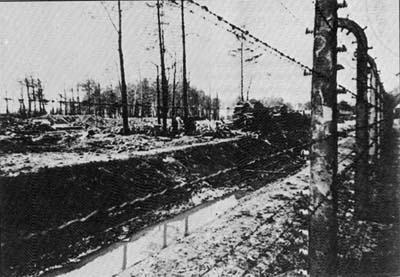| Finally, a common psychological mechanism, he assimilates the girl he loves, Jola and/or Jolka to one of these girls (who were in fact old women whom he would never have wanted in exchange for his Jola-Jolka): |
”…if the photo that fills the whole wall against which so many people perished isn’t that of Jolka, Jolka in the first row of girls running to their deaths in waves of four, hair flying in the wind, a bit of soap in their hands, rushing towards the execution pyre, encircled on all sides by flames.”
|
Thanks to this photo-montage we pass from reasonable history to irrational legend. The tendency to tum the history of the camp into legend was very strong indeed in the 50's, but has since been abandoned. Thus one of the last photographic publications of the Auschwitz Museum, dating from 1980, entitled “KL Auschwitz — Photographic documents”, simply reproduces the three famous Polish Resistance photographs, enlarged but printed from the original negatives (pages 184 and 185, photos 183 [17], 184 [15] and 185 [16].
Having the original photographs makes it possible to identify and precisely locate the scenes and the position of the photographer. Photos 15 and 16 were taken from the inside of a building, through an open door. The only Birkenau Krematorium possessing the three elements to he found on the two photos, a door giving onto a barbed wire fence with the birch wood in the background, was Krematorium V. In the western section there was the door of the western gas chamber meeting these conditions and two doors in the north side, that of the northern gas chamber and the double door of the furnace room. A beam, the end of which is visible on the photos, supported the porch roofs over these doors (not shown on Drawing 2036, but visible on photo PMO neg. no 20995/ 509). The porch roof outside the furnace room was about a metre higher than the door and was not visible from the interior, but those of the gas chambers, where the roof of the building was lower, were only just above the doors and could be seen from the interior. The line of the crowns of the trees in the Birch Wood diminish from left to right. while it would have been horizontal had the picture been taken from the west end of the building. This clue together with the orientation of the shadows indicates that the pictures were taken looking northwest. the photographer being in the northern gas chamber of Krematorium V [see sketch map]. The wind, normally from the north, was blowing from the west, or more likely, northwest.
As regards Photo 17, possession of the original is essential. It shows that the women are concentrated in the bottom left comer, while on the right it is possible to see the top of a Krematorium chimney which does not have the shape of those of Krematorien II and Ill, but those of Krematorien IV and V. The scene cannot have been located at Krematorium IV, with no trees in the immediate vicinity. Krematorium V was surrounded by birch trees. The photo was taken against the light, the south being in front of the photographer and the north behind him, with one of the two chimneys of a type IV/V Krematorium visible on the right. Given this orientation and these clues, the scene could be nowhere other than at the eastern end of an area between the south wall of Krematorium V and the line of frees bordering the Ringstraße. The photographer was to the east of Krematorium V and the three naked women were moving with their backs to the gas chambers in its western part. They were not running, but walking. awaiting their “turn”.
The chimney of Krematorium V, as we might expect is not smoking. We know from David Szmulewski that the four pictures were taken virtually one after the other, with only about fifteen minutes between the first and the last. One of the open-air cremation ditches was therefore operating quite close to the north side of Krematorium V while its furnace was not working, so that contrary to the testimony of Sonderkommando men, the ditches were not in addition to the furnace but were dug to replace it, as it was out of service.
The author, having determined the location of the three photographs and of the Sonderkommando man who took them, had a conversation with Mr David Szmulewski at the end of 1987, and established just how the episode took place:
In the summer of 1944, the Sonderkommando men asked the camp resistance for a small camera so that they could record the criminal tasks they were forced to carry out: emptying of the gas chambers and incineration of the bodies. The Sonderkommando organized some damage to the roof of the gas chambers of Krematorium V and requested repairs. The internal camp resistance then came into action. A “flying squad” to which Szmulewski, a member of this organization, belonged came to repair the damage. Szmulewski was carrying a dixie can with a false bottom in which the camera was hidden. Once the prisoner-repairmen were on the roof, Szmulewski passed the camera to a Sonderkommando man working at the cremation ditch who had placed himself against the north wall of the gas chambers, under the roof overhang which was 2.45 from the ground. This prisoner then quickly entered the north gas chamber whose door was open for ventilation purposes. There he was safe, as the room had already been emptied of corpses. From the centre of this room he took two photographs of his comrades feeding bodies into the cremation ditch. Then, hiding the camera in his right hand, he emerged from the building and went along the north wall to the eastern end of the building then about 30 metres into the wood, moving parallel to the eastern end of the building, under the cover of the trees. In front of the Krematorium, to the south, a group of women considered unfit for work, the next “batch”, was undressing. Some of them were already naked, a little way away from the others, taking a few steps while waiting. The sun was shining right in his face, through the trees lining the Ringstraße, so there could be no question of using the camera normally, using the viewfinder as he had done in the gas chamber. From rather far away, so as not to be noticed, he took a first picture of the women by guesswork. holding his right arm against his side with the camera in his palm. Hidden behind a tree, he wound on the film, emerged and took another picture in the same way as before. The direction the lens was pointing in was difficult to judge under these conditions and he pointed the camera too high, photographing the tops of the trees instead of the women [Photo 18]. Retracing his steps, he returned to the comparative safely of the Krematorium, moving along the north wall to the gas chambers. Szmulewski was watching out for him. A quick look round, no SS. The Sonderkommando man held up the camera which rapidly changed hands again [see the photograph showing the assumed path of the photographer]. Szmulewski replaced the camera in the bottom of the dixie, the repair was completed and the flying squad departed. The whole process had taken only fifteen to thirty minutes. The photos were taken out of the camp and handed over to the Polish resistance in Cracow.
After the Liberation, the prisoner who took the photographs did not come forward, probably having been liquidated after the Sonderkommando revolt on 7th October 1944, so David Szmulewski became the sole survivor of this operation. The honour came to him and he was declared the author of the photographs, though honestly enough he always stated that he had been on the roof of Krematorium V throughout the whole episode. His friendship with Judge Dan Sehn probably counted for much in this designation. After the war, David Szmulewski remained in Poland and was employed in an important post, but in 1968, one of the periodic waves of anti-Semitism swept through the Polish government and he lost his job because he was a Jew. He emigrated to France and has lived there ever since. |
|
 |
Photo 19 |
|
| Photo 20 |
 |
|
 |
Photo 21 |
|

